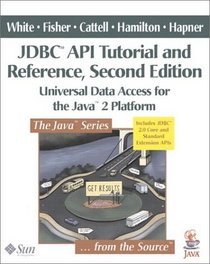Search -
JDBC(TM) API Tutorial and Reference: Universal Data Access for the Java(TM) 2 Platform (2nd Edition)
JDBC API Tutorial and Reference Universal Data Access for the Java 2 Platform - TM - 2nd Edition
Author:
This book provides the definitive description of the JDBC(tm) API, the technology that enables universal data access for the Java(tm) programming language. This new edition has been updated and expanded to cover all of the JDBC 2.0 API, including the JDBC 2.0 core API and the JDBC Standard Extension API, the package that facilitates building ser... more »
Author:
This book provides the definitive description of the JDBC(tm) API, the technology that enables universal data access for the Java(tm) programming language. This new edition has been updated and expanded to cover all of the JDBC 2.0 API, including the JDBC 2.0 core API and the JDBC Standard Extension API, the package that facilitates building ser... more »
ISBN-13: 9780201433289
ISBN-10: 0201433281
Publication Date: 6/11/1999
Pages: 1,059
Rating: ?
ISBN-10: 0201433281
Publication Date: 6/11/1999
Pages: 1,059
Rating: ?
0 stars, based on 0 rating
Genres:
- Computers & Technology >> Web Development & Design >> Internet Commerce >> Web Site Design
- Computers & Technology >> Web Development & Design >> Programming >> General
- Computers & Technology >> Programming >> Java >> General
- Computers & Technology >> Programming >> Java >> Reference
- Computers & Technology >> Databases & Big Data >> Database Design
- Computers & Technology >> Databases & Big Data >> General




